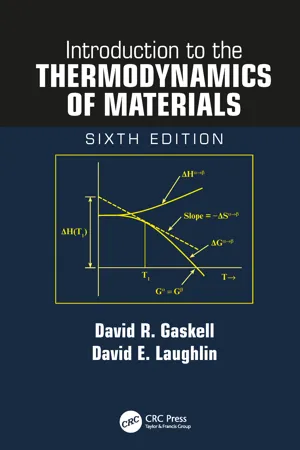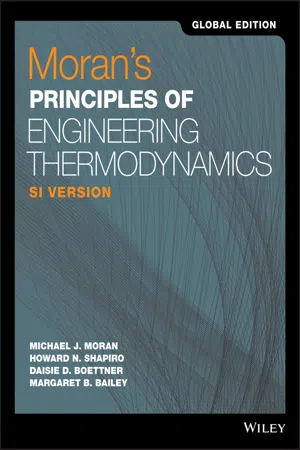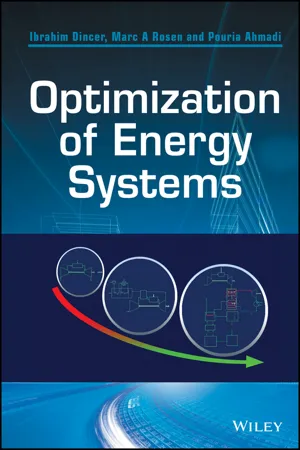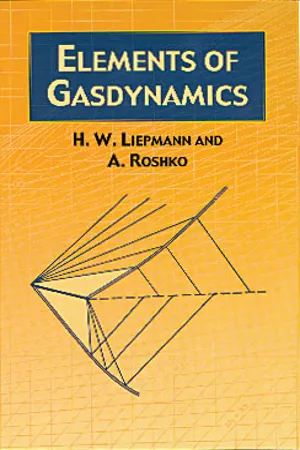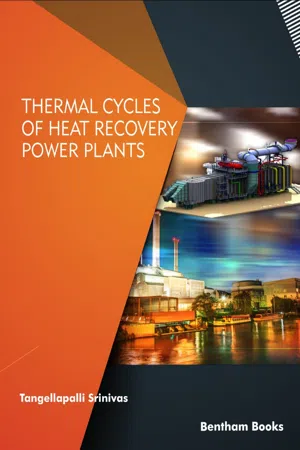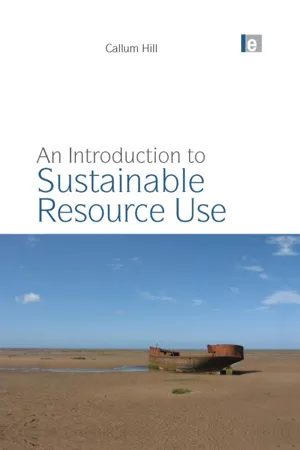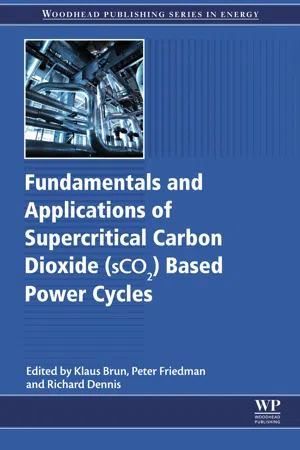Technology & Engineering
Thermodynamic System
A thermodynamic system is a region of space that is under study, and it can be a single object or a group of objects. It is defined by a boundary that separates it from its surroundings. The system can exchange energy and matter with its surroundings, and it is often used to analyze and understand the behavior of various engineering and technological processes.
Written by Perlego with AI-assistance
Related key terms
12 Key excerpts on "Thermodynamic System"
- eBook - ePub
- David R. Gaskell, David E. Laughlin(Authors)
- 2017(Publication Date)
- CRC Press(Publisher)
1 Introduction and Definition of Terms1.1INTRODUCTIONThe term thermodynamics is related to the two Greek words therme and dynamikos , which translate into English as “heat” and “power” (or “movement”), respectively. Thermodynamics is the physical science that focuses on the relationship between energy and work as well as the equilibrium states and variables of systems that are being investigated. Importantly, thermodynamics defines heat and identifies it as the process in which energy is transferred from one region to another down a temperature gradient. In this text, we will mainly use the phrase thermal energy to identify this form of energy transfer, but sometimes the word heat will be used. Thermodynamics deals with the conservation of energy as well as the conversion of the various forms of energy into each other or into work. Thermodynamics is concerned with the behavior of and interactions between portions of the universe denoted as systems and those portions of the universe called the surroundings or the environment . The system is that part of the universe we wish to investigate in detail, and the surroundings is that part of the universe outside the system which may interact with it by exchanging energy or matter. The system may perform work on the surroundings or have work performed on it by the surroundings. The boundary or wall between the system and the surroundings is what allows such interactions. In what we will call simple Thermodynamic Systems , the surroundings interacts with the system only via pressure and temperature changes. The composition remains constant in simple systems.It is convenient to characterize systems by the kinds of interactions that are allowed between them and their surroundings.1.Isolated systems - eBook - ePub
- Michael J. Moran, Howard N. Shapiro, Daisie D. Boettner, Margaret B. Bailey(Authors)
- 2018(Publication Date)
- Wiley(Publisher)
CHAPTER 1 Getting Started Introductory Concepts and Definitions Engineering Context Although aspects of thermodynamics have been studied since ancient times, the formal study of thermodynamics began in the early nineteenth century through consideration of the capacity of hot objects to produce work. Today the scope is much larger. Thermodynamics now provides essential concepts and methods for addressing critical twenty-first-century issues, such as using fossil fuels more effectively, fostering renewable energy technologies, and developing more fuel-efficient means of transportation. Also critical are the related issues of greenhouse gas emissions and air and water pollution. Thermodynamics is both a branch of science and an engineering specialty. The scientist is normally interested in gaining a fundamental understanding of the physical and chemical behavior of fixed quantities of matter at rest and uses the principles of thermodynamics to relate the properties of matter. Engineers are generally interested in studying systems and how they interact with their surroundings. To facilitate this, thermodynamics has been extended to the study of systems through which matter flows, including bioengineering and biomedical systems. The objective of this chapter is to introduce you to some of the fundamental concepts and definitions that are used in our study of engineering thermodynamics - eBook - ePub
- Michael J. Moran, Howard N. Shapiro, Daisie D. Boettner, Margaret B. Bailey(Authors)
- 2018(Publication Date)
- Wiley(Publisher)
national power transmission grid is in place. If this vision of mid-century life is correct, it will be necessary to evolve quickly from our present energy posture. As was the case in the twentieth century, thermodynamics will contribute significantly to meeting the challenges of the twenty-first century, including using fossil fuels more effectively, advancing renewable energy technologies, and developing more energy-efficient transportation systems, buildings, and industrial practices. Thermodynamics also will play a role in mitigating global climate change, air pollution, and water pollution. Applications will be observed in bioengineering, biomedical systems, and the deployment of nanotechnology. This book provides the tools needed by specialists working in all such fields. For nonspecialists, the book provides background for making decisions about technology related to thermodynamics—on the job, as informed citizens, and as government leaders and policy makers. 1.2 Defining Systems The key initial step in any engineering analysis is to describe precisely what is being studied. In mechanics, if the motion of a body is to be determined, normally the first step is to define a free body and identify all the forces exerted on it by other bodies. Newton's second law of motion is then applied. In thermodynamics the term system is used to identify the subject of the analysis. Once the system is defined and the relevant interactions with other systems are identified, one or more physical laws or relations are applied. The system is whatever we want to study. It may be as simple as a free body or as complex as an entire chemical refinery. We may want to study a quantity of matter contained within a closed, rigid-walled tank, or we may want to consider something such as a pipeline through which natural gas flows. The composition of the matter inside the system may be fixed or may be changing through chemical or nuclear reactions - eBook - ePub
Electrochemical Energy Storage
Physics and Chemistry of Batteries
- Reinhart Job(Author)
- 2020(Publication Date)
- De Gruyter(Publisher)
2 ThermodynamicsThermodynamics is a fundamental part of classical physics. It is a closed theory describing macroscopic physical properties – such as the internal energy, entropy, pressure and volume – of matter (and radiation). Thermodynamics shows that the physical properties of matter are subject to general constraints that are common to all substances and materials; anyhow, the appearances of particular properties of specific substances and materials are different. The fundamental constraints are expressed in the thermodynamic laws. These laws completely rule our macroscopic world; and they are described further briefly in this chapter.Thermodynamics is the base of a large variety of topics in science and engineering. It is fundamental for mechanical and chemical engineering. In particular, it describes physical and chemical equilibrium states, and therefore, it is very important for chemistry and chemical reactions. With the help of experimentally measured thermal data, energetic changes of matter and systems can be calculated, and hence, a change of equilibrium states or phase transitions can be predicted and simulated. The same holds for the chemical reactions and processes. Altogether, thermodynamics has a very strong practical relevance in chemistry and engineering.Before we discuss the fundamental four laws of thermodynamics, in the following subsection, we introduce a variety of physical terms and definitions, which are necessary for the later explanations.2.1 Terms and definitions
Dealing with thermodynamics requires a set of definitions and a good understanding of the physical terms and wordings, which has to be clarified before further explanations and discussions are presented.2.1.1 Systems
A system is a macroscopically spatially well-defined part of the universe. It is the special part of the universe that is to be studied or analyzed, and it is separated from the surroundings (Figure 2.1 - eBook - ePub
Fluid and Thermal Dynamics Answer Bank for Engineers
The Concise Guide with Formulas and Principles for Students and Professionals
- Ethirajan Rathakrishnan(Author)
- 2023(Publication Date)
- BrownWalker Press(Publisher)
Chapter 8
Thermodynamics
8.1Basic Concepts and Definitions
Thermodynamics may be defined as the study of energy, its forms and transformations, and the interaction of energy with matter. Thermodynamics deals with the conservation of energy from one form to another.The first law of thermodynamics is an expression of the energy conservation principle. The second law of thermodynamics asserts that spontaneous processes occur only in a particular direction and never in a direction opposite to that. Further, it ascertains that energy has quality as well as quantity .A macroscopic approach to the study of thermodynamics which does not require a knowledge of the behaviour of the individual particles of the substance is called classical thermodynamics . An elaborate approach, based on the behaviour of individual particles is called statistical thermodynamics .A closed system or control mass is a fixed amount of mass, and no mass can cross its boundaries but energy can cross its boundaries. An open system or control volume is a properly chosen region in space. Both mass and energy can cross the boundary of a control volume but the shape of the control volume will remain unchanged.The sum of all forms of energy of a system is called its total energy E . The total energy of a system is made up of microscopic energy group and macroscopic energy group . The internal energy is the sum of all the microscopic forms of energy.The portion of the internal energy of a system, associated with the kinetic energy of the molecules is called the sensible energy . The internal energy associated with the phase of a system is called the latent energy . The internal energy associated with the bonds in a molecule is called the chemical or bond energy - eBook - ePub
- Ibrahim Dinçer, Marc A. Rosen, Pouria Ahmadi(Authors)
- 2017(Publication Date)
- Wiley(Publisher)
Chapter 1 Thermodynamic Fundamentals1.1 Introduction
Energy plays a critical role in driving almost all practical processes and is essential to sustain life. Energy exists in several forms, for example, light, heat, and electricity. Energy systems are widespread and used in diverse industries such as power generation, petrochemical processing, refrigeration, hydrogen production, chemical processing, and manufacturing. Interest is growing in producing superior energy products at minimal cost, while satisfying concerns regarding environmental impact, safety, and other issues. It is no longer adequate to develop a system that simply performs a desired task. For various reasons, it is often important to optimize processes so that a chosen quantity, known as the objective function, is maximized or minimized. For example, the output, profit, productivity, product quality, and so on, may be maximized, or the cost per item, financial investment, energy input, and so on, may be minimized. The success and growth of industries today is strongly based on their ability to optimize designs and systems.When an engineer undertakes the analysis of an energy system and/or its application, she or he should deal with several basic factors first. These depend on the type of the problem being studied, and often involve such disciplines as thermodynamics, fluid mechanics, and heat transfer. Consequently, it is helpful to introduce several fundamental definitions and concepts before moving on to detailed energy systems applications, especially for readers who lack a background in thermodynamics, fluid mechanics, or heat transfer.This chapter provides such a review, and is intended to give novice and practicing energy systems engineers a strong understanding of fundamentals, including physical phenomena, basic laws and principles, and governing relations, as well as a solid grounding in practical aspects. This introductory chapter covers relevant fundamentals involved in the optimization of energy systems. We begin the chapter with a summary of fundamental definitions and physical quantities, with their units, dimensions, and interrelations. We then consider introductory aspects of thermodynamics, with a particular focus on energy, exergy, and heat transfer. - No longer available |Learn more
- Steven Boone, Drew H. Wolfe(Authors)
- 2011(Publication Date)
- Collins Reference(Publisher)
universe , uni: uni = sys + surrOpen and Closed SystemsThermodynamic Systems are classified as either being open or closed. An open system allows both matter and energy transfers into or out of the system. A closed system allows only energy transfers. In other words, closed systems have a constant mass.Adiabatic and Isothermal SystemsSystems may also be classified according to the properties of the walls that separate the system from the surroundings so that no energy transfers; such a system is an adiabatic system . An example of an adiabatic system is a thermos bottle. If the walls of the system allow energy transfers, the system is an isothermal system . Most of the chemical reactions that we will study are isothermal systems.Exercise 7.1 (a) Explain what happens to the temperature of an isothermal system when heat is produced or absorbed by the system, (b) Compare this to an adiabatic system. Solution 7.1(a) If an isothermal system releases heat, heat flows to the surroundings and does not raise the temperature. If an isothermal system absorbs heat, the surroundings replace the heat. In either case, the overall temperature of an isothermal system remains constant, (b) If an adiabatic system releases or absorbs heat, the temperature of the system increases or decreases accordingly, because the heat is trapped in the system.Properties of Thermodynamic SystemsThermodynamic properties can be used to describe the state of a system. For example, the pressure, P , volume, V , and temperature, T , of a sample of helium gas (the system) may be measured. Any measurement that affects or is affected by energy changes in the system is a thermodynamic property. The collection of values for the thermodynamic properties of a system is called the thermodynamic state of the system - eBook - ePub
- H. W. Liepmann, A. Roshko, A. Roshko(Authors)
- 2013(Publication Date)
- Dover Publications(Publisher)
Thermodynamics predicts the pressure and temperature in this final state easily. Fluid mechanics of a real fluid should tackle the far more difficult task of computing the pressure, temperature, etc., as a function of time and location within the container. For large times, pressure and temperature will approach the thermodynamically given values. Sometimes we need only these final, equilibrium values and hence can make very good use of thermodynamic reasoning even for problems that involve real fluid flow. In fluid mechanics of low-speed flow, thermodynamic considerations are not needed: the heat content of the fluid is then so large compared to the kinetic energy of the flow that the temperature remains nearly constant even if the whole kinetic energy is transformed into heat. In modern high-speed flow problems, the opposite can be true. The kinetic energy can be large compared to the heat content of the moving gas, and the variations in temperature can become very large indeed. Consequently the importance of thermodynamic concepts has become steadily greater. The chapter therefore includes material that is more advanced and not needed for the bulk of the later chapters. Articles that are starred can be omitted at first reading without loss of continuity. 1.2 Thermodynamic Systems A Thermodynamic System is a quantity of matter separated from the “surroundings” or the “environment” by an enclosure. The system is studied with the help of measurements carried out and recorded in the surroundings. Thus a thermometer inserted into a system forms part of the surroundings. Work done by moving a piston is measured by, say, the extension of a spring or the movement of a weight in the surroundings. Heat transferred to the system is measured also by changes in the surroundings, e.g., heat may be transferred by an electrical heating coil - eBook - ePub
- Tangellapalli Srinivas(Author)
- 2021(Publication Date)
- Bentham Science Publishers(Publisher)
viz. turbine, condenser, pump, and boiler. The feedwater is heated with a heat source and turned into superheated steam. Inthe condenser, the vapour is condensed into a saturated liquid state by air circulation or water circulation. The power plant handles various fluid lines such as fuel, air, cooling oil, steam, circulating water, feedwater, and hot gas. Similarly, the systems also involve heat and work transfers. Therefore, the Thermodynamic System can be described with mass and energy transactions. To understand the nature of system, it is required to define the terminology used in the system, and they are surroundings, boundary, control surface, control volume, etc. The space outside the system is called as surroundings. Boundary is the enclosure that separates the system from the surroundings. The boundary may be real or imaginary. It is a stationary boundary or moving boundary. The system and its surroundings together are called as the universe. Thermodynamic Systems can be grouped into an open system, closed system, and isolated system.In an open system, the mass and energy cross the boundary. In this system, the fixed region in space is the control volume, and the surface of the control volume is called as the control surface. For example, in a steam boiler, feedwater enters into the system and leaves as a superheated steam (mass transfer) by absorbing heat (energy interaction). Compresser, turbine, nozzle, diffuser, steam engine, boiler, etc., are the open systems. If a system allows mass without energy transfer, such as steam flowing in an insulated pipe, that is also an open system. In this case, even though there are no energies crossing the boundary, because of insulated pipe, the fluid carries energy along with the flow, which is called kinetic energy. In addition to this kinetic energy, it also possesses flow work. The frictional resistance in the insulated pipe drops the fluid velocity. So within the control volume, the energy exchange occurs without crossing the control surface or boundary. Therefore a system with mass flow, but without work and heat flow, can be treated as an open system. A system is called a closed system if it does not allow the matter to enter or leave and the energy (heat and work) across its boundary. Examples are gas enclosed in a cylinder, water stored in a container, electronic device, etc. - eBook - ePub
- Callum Hill(Author)
- 2012(Publication Date)
- Routledge(Publisher)
Historically, thermodynamics concerned itself with properties such as work, energy and heat at a time before it was known that matter was made of atoms. As we have seen, the caloric theory was in favour until about 1850 when it was finally realized that heat was just one form of the many different types of energy. It was also about this time that thermodynamics began to gain a firm scientific footing.Rather than limiting itself to machines, thermodynamics developed a more generic approach; one very important concept which was introduced was that of the system. A system comprises something we wish to study, which might be a heat engine, but could be anything (Atkins, 1986; Everett, 1971). Around the system are the surroundings and between the two is something called a system boundary. The boundary may have a physical existence, or it can be purely conceptual. The experi- mental system boundary is the place where measurements are taken, with energy and sometimes matter flowing across this boundary. Different systems can be defined and described as either open, closed or isolated. An open system is one that can exchange matter and energy through the boundary with its surroundings, a closed system can exchange energy but not matter and an isolated system cannot exchange matter or energy with its surroundings.The surroundings represent everything that is not in the system, in other words the rest of the universe. When something passes through the system boundary, this changes the internal energy of the system. This might be heat energy passing through, or we might perform mechanical work on the system (such as compressing air in a bicycle pump). This idea is stated in the First Law of Thermodynamics. - Klaus Brun, Peter Friedman, Richard Dennis(Authors)
- 2017(Publication Date)
- Woodhead Publishing(Publisher)
For brevity, relatively few references are given, but introductory material may be found in any thermodynamics textbook, such as Moran and Shapiro (2008) or Klein and Nellis (2012). References on second law analysis tend to be in advanced thermodynamics textbooks, such as Wark (1995) or more specialized references such as Moran (1982) or Pioro and Romney (2008). In addition to thermodynamics, basic heat transfer and fluid mechanics relationships are discussed, with an emphasis on the effect on plant balance equations. Thermodynamics is the study of energy transformations and the relationships among properties of substances. The first law of thermodynamics states that energy cannot be created or destroyed, or more succinctly, energy is conserved. Heat engines are Thermodynamic Systems that receive heat from a heat source and produce work. According to the second law of thermodynamics, heat engines must also reject a portion of the heat received to a lower temperature heat sink. The heat supplied can result from burning fossil fuels, process waste heat, geothermal sources, solar energy, or nuclear fission. The heat sink can be an environmental component, such as the atmosphere or a body of water, or alternatively, the heat can be used for other applications such as industrial process heat or as a heat source for a heat engine operating at lower temperatures (so-called bottoming cycles). Heat engines, such as the example shown in Fig. 3.1, operate in thermodynamic cycles, which are a series of processes that repeat over time and use a working fluid, which is traditionally, and most commonly either gas such as air, or a vapor undergoing a phase change such as water- Stanislaw Sieniutycz, Jacek Jezowski(Authors)
- 2013(Publication Date)
- Elsevier(Publisher)
The scope of this chapter is not only to review and classify the main methods and results obtained in the field but also to consider common objections caused by misunderstanding of these methods and results. In fact, the second part of the chapter contains a critical comparison of various methods applied for the systems of energy generation, such as second-law analyses, entropy generation minimization, approaches coming from ecology, and finite-time thermodynamics. Systems considered are those with transfer or rate processes that occur in a finite time and in equipment of finite dimensions. These processes include heat and separation operations and are found in heat and mass exchangers, thermal networks, energy convertors, energy recovery units, storage systems, chemical reactors, and chemical plants.11.2 System energy analyses
In process analysis the assessment of energy impact is constrained to the interior of the balance shield of the considered unit; this is how direct energy consumption is determined. Yet it should be realized that no real energy unit can operate as a separate system but is a component of a global energy system. In fact, the production and consumption of energy carriers always takes place within the network of interconnected thermal units. Therefore, both the direct consumption of energy carriers in the unit investigated and the indirect consumption occurring in other units must be analyzed. For this purpose the system approach should be applied (Bertallanffy, 1973 ; Klir, 1972 ; Leontief, 1951 ; Mielentilew, 1982 ). Application of the system approach to investigate problems of industrial thermal engineering started in the 1960s. The elaboration of a mathematical model for material and energy balance of an industrial plant using the example of ironworks may be considered (Szargut and Ziębik, 1972 ).11.3 Mathematical modeling of industrial energy management
To proceed in a systematic way, a total system is often divided into subsystems. In an industrial plant the technological subsystem (consisting of technological processes) and the energy subsystem (energy management) are distinguished. The production of the energy branches is intended to cover the needs of the technological branches and, partially, also the plant’s own consumption. The complexity of connections between energy management and technological branches, as well as the interdependences between the energy branches, causes the total energy management of an industrial plant to be more than the sum of energy processes considered separately. Some of these relations are of a feedback character. Therefore, all balance equations of energy carriers should be investigated as a whole. Thus, the energy management of an industrial plant is a system defined as a set of energy equipment and engines, as well as the inner relations between them and the external relation between energy management and the environment, the aim of which is the production, conversion, transmission and distribution of energy carriers consumed in industrial plants. Because of these relations energy management, treated as a complex, has attributes which its parts (the particular energy branches considered separately) do not possess.
Index pages curate the most relevant extracts from our library of academic textbooks. They’ve been created using an in-house natural language model (NLM), each adding context and meaning to key research topics.
